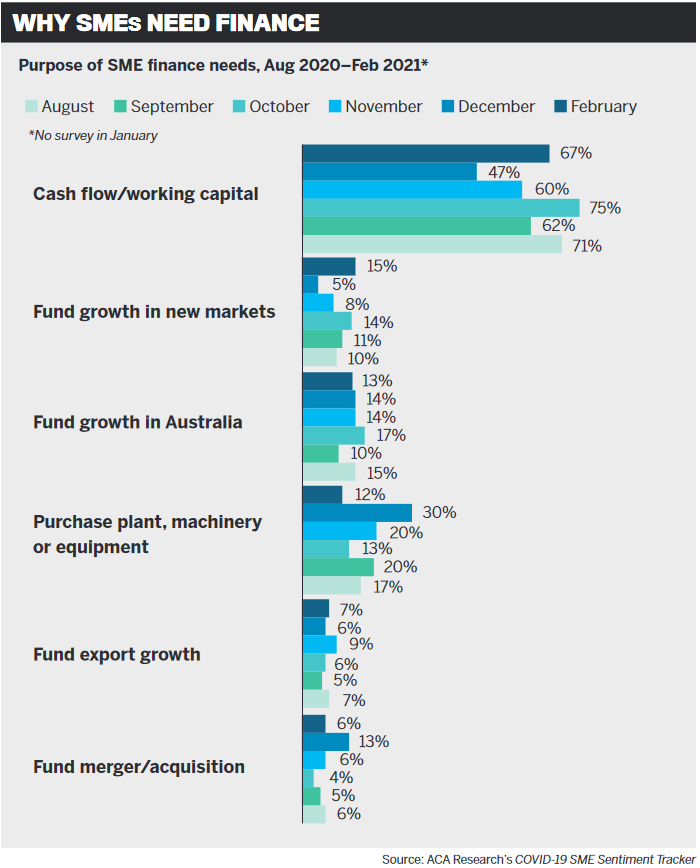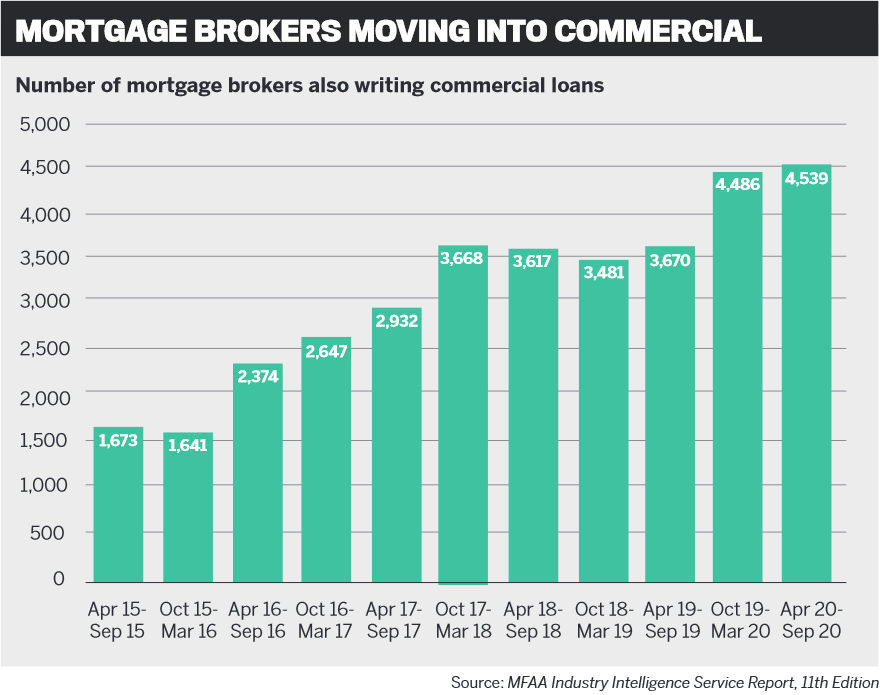Emerging this year with a renewed sense of business confidence, SME owners are looking ahead to growth and expansion opportunities

Businesses across Australia struggled last year through restrictions and lock-downs, and as confidence fell, lending to businesses also declined. In April 2020, two thirds of SMEs reported a drop in revenue as around one in four either temporarily or permanently shut their doors, according to ACA Research’s COVID-19 SME Sentiment Tracker.
The outlook improved much faster than many expected, however. Across most of the country, shops, pubs and other venues began opening their doors after just a couple of months, and confidence began to soar. While there were other sporadic outbreaks and Victoria in particular saw strict restrictions return, the SME Sentiment Tracker showed that almost half of SMEs were trading at pre-COVID levels.
There has also been growth in the number of SMEs intending to hire, and a redirecting of funds away from help with cash flow towards growth initiatives, including investing in new plant and equipment.
Banks and lenders are also experiencing increased demand. Greg Pell, Westpac Group’s national general manager, specialised lending and transactional banking, says while there is still some level of uncertainty out there, businesses are ready to start growing again.
Westpac Group has seen customers across mining, manufacturing, wholesale, transport and construction industries take advantage of record-low interest rates and incentives to invest in business equipment.
“The past 12 months have been extremely challenging, but our customers have shown resilience and the ability to adapt to the changing economic conditions,” Pell says.
“Business confidence is high, with optimism evident in all the states and across many sectors. The economy has considerable momentum, with activity rebounding rapidly as restrictions are eased further, the vaccine is rolled out and a tailwind from policy stimulus.”
As more businesses seek finance, the opportunities for mortgage brokers to expand their own offering grows. Pell says a broker’s portfolio already comprises between 20% and 40% of self-employed customers, all of which will have an asset finance requirement at some point.
 “Whether it’s a car, truck, office equipment or machinery, these businesses can utilise asset finance. The gap with many SME businesses is having this need identified and the right path-ways to bring the finance to them,” Pell says.
“Whether it’s a car, truck, office equipment or machinery, these businesses can utilise asset finance. The gap with many SME businesses is having this need identified and the right path-ways to bring the finance to them,” Pell says.
Offering asset finance is different to providing a home loan, however, and brokers need to be aware of that. The loan cycle spans days rather than weeks, and as the product is for business purposes it’s usually a less emotional purchase. Pell adds that an asset or piece of equipment is usually required as soon as possible to start generating an income.
It’s not a completely different ball game, though. “The fundamentals of knowing your customer, understanding their business, and genuinely wanting to provide help is no different to what is required of a mort-gage broker,” Pell says.
The biggest pain points for brokers over the last year have been turnaround times and channel conflict, but he says Westpac has worked on a service that fully supports brokers. Its online origination platform enables brokers to quote, submit applications and generate loan documentation for their customers.
The major bank has also recently reintroduced matrix lending policies as the economy strengthens post COVID-19, allowing for decision turnarounds of just hours from lodgement for eligible customers. It has dedicated teams to process and make decisions on asset finance applications.
“Our business bankers understand the role of a broker and that customers can and will engage their services,” Pell says. “We certainly respect the customer’s choice to utilise the channel that best suits their business.”
Technology has been crucial in not only speeding up turnaround times but making it easier for brokers to diversify.
Specialist Finance Group gives brokers the ability to navigate asset finance products through its CRM SFGConnect and apply directly to lenders, in much the same way as they would apply for a home loan.
At the same time, the group’s head of aggregation, Blake Buchanan, warns brokers against thinking that they need to be good at offering every type of product.
“Diversification has been a buzzword in the industry for more than a decade now, and often this gets interpreted as brokers needing to be masters of residential, asset and commercial finance, among other things,” Buchanan says.
“In practice, though, very few in the industry have had the capacity to be experts in all of these fields simultaneously.”
In fact, some of the best brokers he knows mainly “stay in their lane” but offer a diversi-fied service through other means. Buchanan says many brokers partner up with special-ists in other areas, employ or subcontract to specialists, or have referral partnerships with companies that specifically cater to asset and commercial finance.
Nevertheless, having asset finance in their arsenal is invaluable to a broker, he says. With brokers cementing themselves as the channel of choice for customers, and asset finance transactions going “hand in hand” with other transactions, it “makes sense” that a broker can source solutions from a wide range of products and policies.

“It is our, the lenders’, and the brokers’ obligation themselves to educate brokers around these offerings so that they are not only aware of the products and policies but empowered with the knowledge and skills to identify and act on these opportunities,” Buchanan says.
Brokers probably already have potential asset finance customers in their books, which can often be undervalued or not tapped into in a meaningful way.
Buchanan says in reaching out to existing clients, “the first step is the easiest”: simply let them know you can help them in this area.
“Be clever with your discovery of your clients’ needs, and identify opportunities to assist where appropriate. This might mean scheduling follow-ups with your clients outside of your normal cycles to suit their timeline for asset purchases as an example,” he says.
When taking on asset finance customers, brokers need to be aware of all their financial commitments and have a thorough under-standing of their present and future plans to ensure any solution offered is in their best interests.
Much the same as with a mortgage, a broker offering asset finance will need to compare the products available and select the most appropriate solution for the borrower.
Buchanan encourages brokers to educate themselves on all the different types of asset finance products on the market and be across the range of different providers that are exposure, they asked more questions and were soon able to find pain points in the client’s business. The broker then helped the business owner buy a new oven so they could double their bread production, resulting in a great financial outcome for the business.
“Brokers need to not just scratch the surface with their enquiries but be prepared to deeply understand their client’s situation and be educated enough in different areas to identify and further assist their clients,” Buchanan says.



